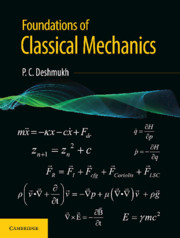Book contents
- Frontmatter
- Dedication
- Contents
- List of Figures
- List of Tables
- Foreword
- Preface
- Introduction
- 1 Laws of Mechanics and Symmetry Principles
- 2 Mathematical Preliminaries
- 3 Real Effects of Pseudo-forces: Description of Motion in Accelerated Frame of Reference
- 4 Small Oscillations and Wave Motion
- 5 Damped and Driven Oscillations; Resonances
- 6 The Variational Principle
- 7 Angular Momentum and Rigid Body Dynamics
- 8 The Gravitational Interaction in Newtonian Mechanics
- 9 Complex Behavior of Simple System
- 10 Gradient Operator, Methods of Fluid Mechanics, and Electrodynamics
- 11 Rudiments of Fluid Mechanics
- 12 Basic Principles of Electrodynamics
- 13 Introduction to the Special Theory of Relativity
- 14 A Glimpse of the General Theory of Relativity
- Index
11 - Rudiments of Fluid Mechanics
Published online by Cambridge University Press: 06 November 2019
- Frontmatter
- Dedication
- Contents
- List of Figures
- List of Tables
- Foreword
- Preface
- Introduction
- 1 Laws of Mechanics and Symmetry Principles
- 2 Mathematical Preliminaries
- 3 Real Effects of Pseudo-forces: Description of Motion in Accelerated Frame of Reference
- 4 Small Oscillations and Wave Motion
- 5 Damped and Driven Oscillations; Resonances
- 6 The Variational Principle
- 7 Angular Momentum and Rigid Body Dynamics
- 8 The Gravitational Interaction in Newtonian Mechanics
- 9 Complex Behavior of Simple System
- 10 Gradient Operator, Methods of Fluid Mechanics, and Electrodynamics
- 11 Rudiments of Fluid Mechanics
- 12 Basic Principles of Electrodynamics
- 13 Introduction to the Special Theory of Relativity
- 14 A Glimpse of the General Theory of Relativity
- Index
Summary
Surrender to the flow of the River of Life, yet do not float down the river like a leaf or a log. While neither attempting to resist life, nor to hurry it, become the rudder and use your energy to correct your course, to avoid the whirlpools and undertow.
—Jonathan Lockwood HuieTHE EULER'S EQUATION OF MOTION FOR FLUID FLOW
In the previous chapter, we studied the Kelvin–Stokes theorem. When restricted to just two dimensions, it is referred to as the Green's theorem which is therefore only a special case of the Kelvin–Stokes theorem. Using the Green's theorem, we are automatically led to another prodigious theorem in the analysis of complex functions, known as the Cauchy's theorem. The methods developed in Chapter 10 are of great importance in fluid dynamics, electrodynamics and also in quantum dynamics. Practical applications of these methods are abundantly found not merely in fluid dynamics but also in the study of plasma in stellar atmosphere, and the analysis of charge plasma produced by lasers. The techniques are therefore of great consequence in engineering and technology, apart of course, from basic sciences. In this chapter, we shall use these methods to develop the equation of motion for a classical fluid.
The central question in mechanics is how to describe the state of a system, and how the system evolves with time. We have learned in earlier chapters that the state of a material particle system is represented by its position and momentum in the phase space. The temporal evolution of the system is provided by its equation of motion, viz., the Newton's equation of motion, or equivalently by the Lagrange or the Hamilton's equation of motion, which are discussed in earlier chapters. Much of the study of classical mechanics is about setting up the equation of motion, and learning to solve the same. When the medium is the continuum fluid, the system is very complex. It cannot be described as particles, and its evolution cannot be simply described by the usual familiar form of the Newton's, Lagrange's, or Hamilton's equations, even if the basic tenets of classical mechanics remain applicable. A fluid consists of a large number of fluid ‘particles’, which is an idea that is not defined exactly the same way as that for a piece of sand.
- Type
- Chapter
- Information
- Foundations of Classical Mechanics , pp. 384 - 416Publisher: Cambridge University PressPrint publication year: 2019



